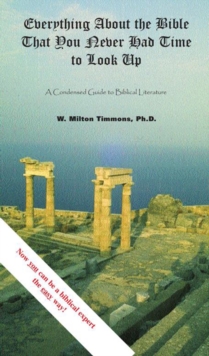Visit the author's website at www.miltontimmons.com.Heretofore it has required years of study, access to many rare books, and superhuman effort to cut through the nearly impenetrable prose of these ancient books. Now all the hard work has been done for you in this easy to read summary. The project began during the course of collecting background material for a novel about the origins of Christianity when it soon became apparent that reliable information was very scarce. Perhaps half the books that shaped Western concepts of religion have ceased to exist. Many were destroyed as heretical after the early ecumenical councils closed the biblical canon in the fourth century; others have simply turned to dust. The oldest biblical manuscripts in existence are the Dead Sea Scrolls, which go back to approximately 100 B.C.E. And the oldest Christian manuscripts are those found in the Gnostic library of Nag Hammadi, in Egypt written in the fourth century C.E. But they dont contain any of the canonical books. All other information comes to us via copies of copies. Before invention of the printing press in 1450, all replication was by hand which allowed countless variations to creep into texts. Especially after translation into multiple languages, many stories evolved into a wide spectrum of versions. Which is the true version? It is impossible to say. The aim of this volume is to be concise rather than exhaustive thus making available to general readers the main sources of Judeo-Christian thought, without the distraction of scholarly disputes. For the benefit of those who may question the interpretation of certain documents, or who wish more information about original sources, a selected bibliography is included. It should be remembered that the books in this volume were written by very primitive people who were trying to make sense of the world with the only information they had. But even in those days, most of these authors were not considered educated by their Greek and Roman contemporaries. Moreover, the Jewish and Christian leaders who created the biblical canon rejected the majority of these documents as products of overheated imagination. So there are times when descriptions necessarily become a bit whimsical. Always, however, the goal has been to cover the authors main points while eliminating only the extraneous. Even though many of these books did not end up in any authorized Bible, they have nevertheless been extremely influential in the evolution of religious traditions. To this day, sermons, theological doctrines, and Sunday school lessons are still based on these extra-canonical sources: Where did medieval artists get the idea for all those paintings about the Assumption of the Virgin? Theres nothing in the Bible about any such event. How do Catholics justify their doctrine that Mary remained a virgin all her life even though the Bible says Jesus had several brothers and sisters? Where did Dante Alighieri get his concepts about the levels of hell? Where did John Milton get the plot for his story about Lucifer the fallen angel?The documents contained in this book are where those ideas, and a myriad others, all came from.


